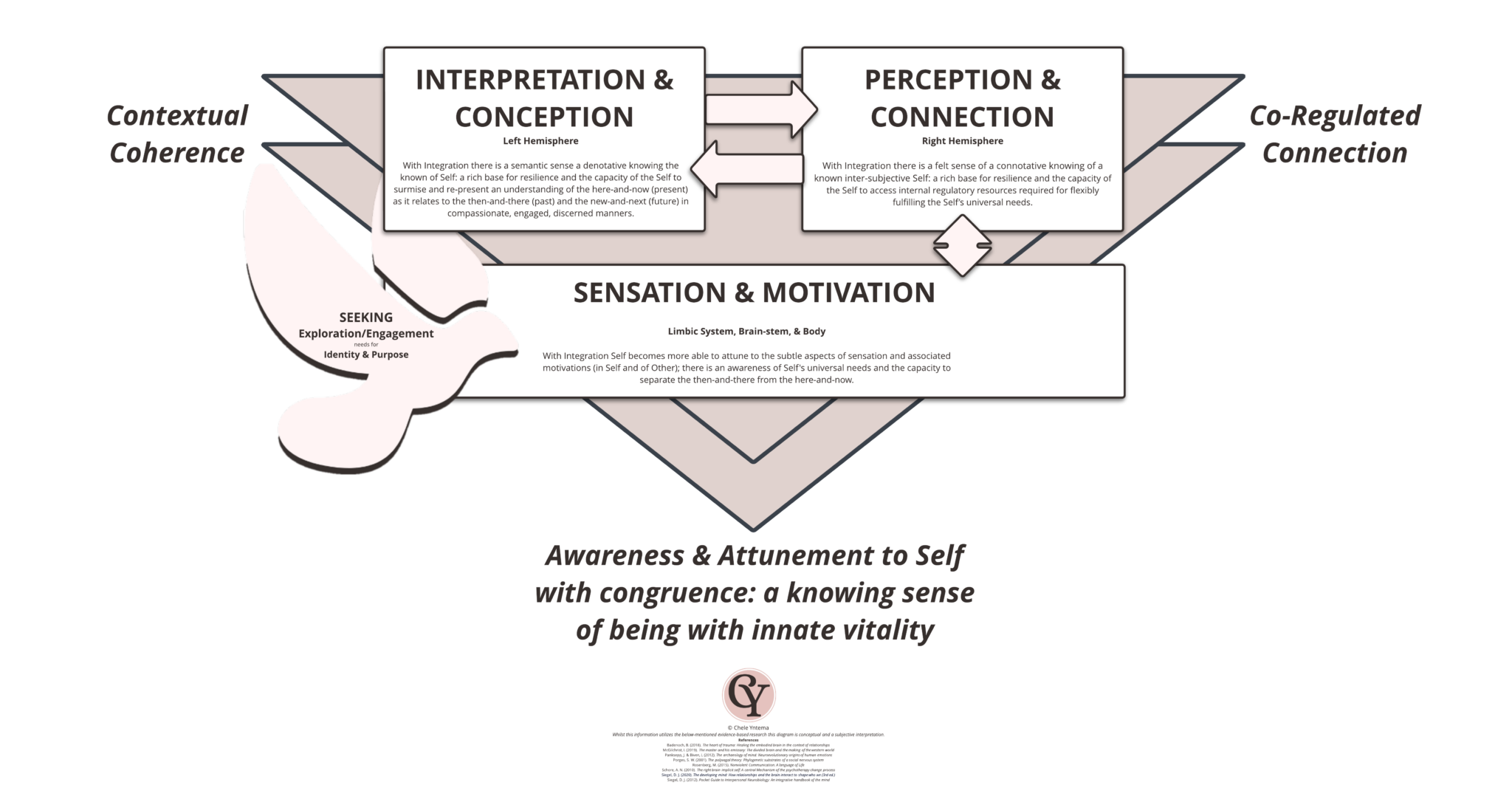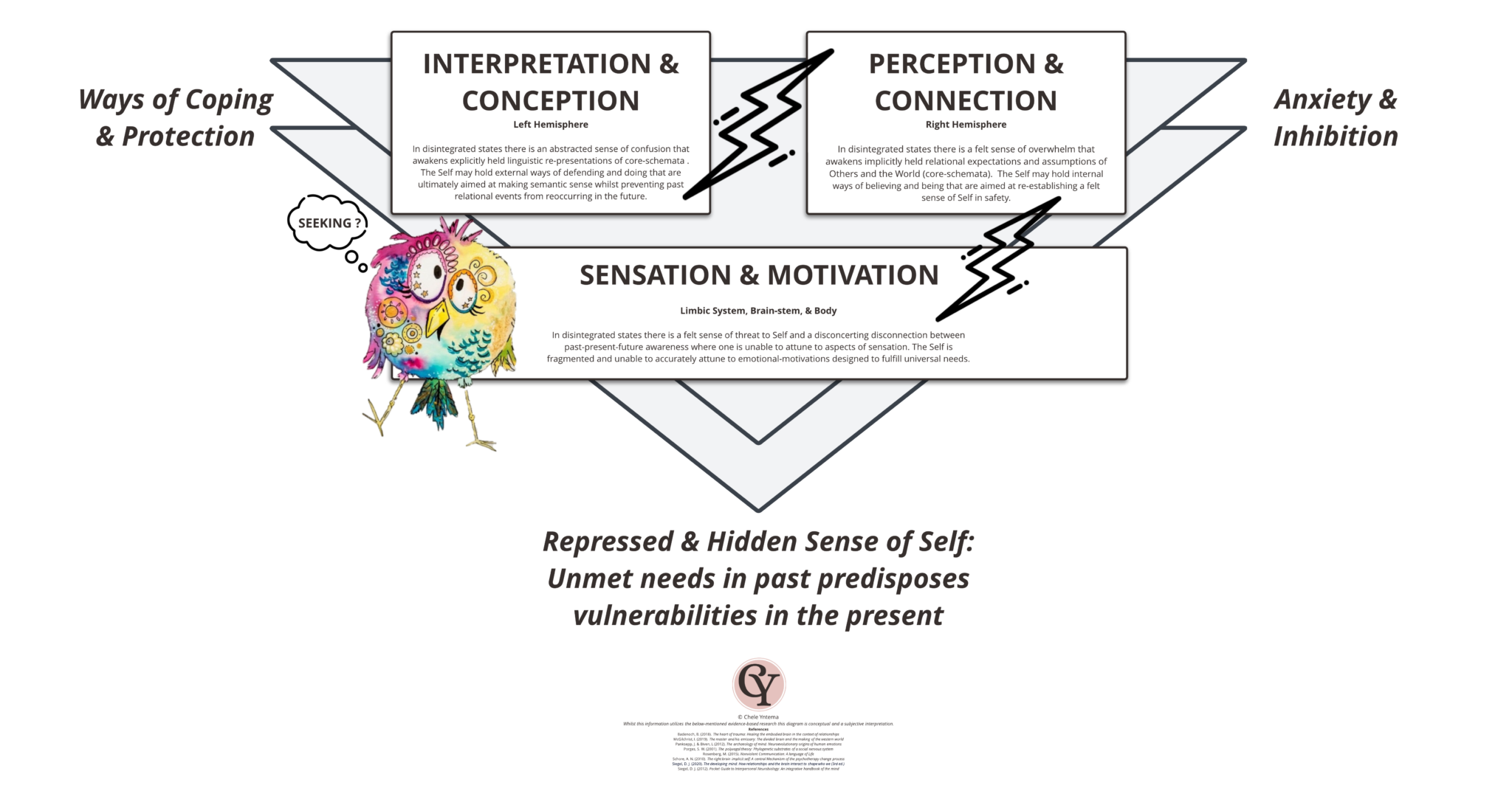Contents of Article
- 1 MIND BODY CONNECTION
- 2 & the Functional Fundamentals of Humanity
- 3 Defining Wellbeing and Suffering
- 3.1 Wellbeing is based in Integration, Health and Wellness
- 3.2 Suffering is based in Disintegration, Disorder, and Illness
- 3.3 Theory of Change: What Integration and Disintegration, Health and Disorder, Wellness and Illness Implies for my Practice
- 4 Psychotherapeutic Counselling
MIND BODY CONNECTION
& the Functional Fundamentals of Humanity
The attempt to escape from pain, is what creates more pain.
Gabor Mate
Defining Wellbeing and Suffering
When we appreciate the fundamental nature of human experience and the fundamental constitution of Self as it relates to Other(s) and the World we can begin to appreciate more fully what it means to be well, what it means to suffer, and why as humans we seek connection to a stronger-wiser Other in times of chaos, confusion, distress, despair, and ultimately overwhelm.
For more information on my perspective of the Mind-Body Connection
& the Functional Fundamentals of Humanity feel free to view
The Fundamental Constitution of Self.
Through my research and practice I have come to value that well-being resides within a coherent and connected (integrated) sense of Self; a uniquely individual flow of being (right brain) and doing (left brain): a fluidity of physiological, psychological, and relational synchrony and equanimity that produces health and wellness throughout the ever-changing milieus of life.
More expressly, the term well-being is a linguistic expression used to accentuate the dynamic synchronisation of flowing energy and information that allows for continued equanimity within our diachronic sense of Self, Other(s), and world.
This continued equanimity allows the Self to feel resonantly seen, heard, understood, accepted, valued, and delighted in (primarily established by the Other), which in turn opens opportunities for a moment-to-moment attuned reciprocity to the humanness within and between. This is an ever-evolving embodied and relational flow that is informed and regulated by the neurobiological way in which we sense, perceive, interpret, and adaptably react or respond to situational stimuli (internally and externally; interpersonally and intrapersonally).
Most vitally, well-being is not-not suffering.
Rather, it is a bringing forth of safe communicative reciprocity which allows for an unfolding of the Self’s innate every-emerging ability to find motivational clarity and an intuitive knowing of what is needed to restore idiosyncratic equanimity. That is, with dynamic synchronisation the Self’s inherent capacity to move toward optimal functioning by way of enhanced flexibility and resilience emerges.
Importantly such dynamicism is, anthropologically and ecologically, reflective of our True nature: designed as Self’s who are open, nonlinearly affected beings, that recursively shape and are shaped by a flow of energy and information across time. Indeed, and to articulate, we are ever-emerging, self-organising creatures who are a part of an ever-emerging, self-organising World: complex systems within complex systems.
Paradoxically, whilst as complex systems we hold the inherent capacity to move toward coherence and thus health and wellness, as complex systems we also hold the capability to enter chaotic disintegrative states: whilst we are designed for integration, without connection, belonging, and communicative meaning-making our systems move into disorder and illness – we begin to ‘suffer’.
Thus, suffering is the disintegration of the Self’s ability to adaptively respond; rather the Self moves into more reactive patterns of protection – affectually, relationally, semiotically, and semantically.
These reactive patterns of protection, or defences, may for a time reduce states of suffering, however, often result in the Self becoming dysregulated, dissonant, or disassociated to the point of separation. The Self is separated from the innate propensity that allows for continued SEEKing, finding and acquiring life, becoming stagnant without the capacity to morn and find meaning, thus without the capacity to integrate here-and-now as it relates to the then-and-there and the new-and-next – a downward spiral ensues.
With this in mind, I outline some of the important definitions for my practice before moving on to my theory of change:
Wellbeing is based in Integration, Health and Wellness
Health is a state of body. Wellness is a state of being. J. Standord
Integration
Integration refers to the linkage of differentiated elements of physiological, psychological, and relational functioning.
It is the mind’s capacity to discern and weave together distinguished modes of processing –including affective and neuroceptive sensation, relational and regulatory perception, as well as semantic and sense-making interpretations. This integrative process enables a spatiotemporal emergence of the here-and-now as it connects to the then-and-there and opens toward the new-and-next.
In the context of well-being integration reflects both a property and a process of Self: the affective dynamic development of a coherent sense of Self with an Other in the World.
Finally, with integration our sense of Self is embraced and grounded in continual contextual coherence – with integration the Self is congruent and connected.
Health and Wellness
In general, I employ the terms health and well-being to represent the objective and subjective elements of experience that indicate states of balance or equilibrium. Health and wellness arise from the process of integration. As an objective element of experience, health is that which holds a quantifiable perspective of a state of effectual normality – this includes a sociocultural bias and a directed attention toward that which measurably enhances optimal regulation and biopsychosocial functioning. Conversely, and as an element of subjective experience, wellness is that which holds an unquantifiable Self perspective of an individual’s state of being – this includes a directed attention toward an unmeasurable internal knowing of coherence and congruence. Both health and wellness include how the Self connects with Other(s) and the World, adapting coherently and contextually which in turn broadens and builds the Self’s capacity to meet challenges with rigor. Well-being further incorporates how, when integrated, the Self innately moves toward potentiality with purpose and meaning.
Importantly “health and wellness from this perspective is a systems process, one that emerges as an individual is integrated both internally within the body and relationally within connections to other people and to the World (environment)” (Siegel, 2012, p. 38.1).
Suffering is based in Disintegration, Disorder, and Illness
Many of us today live lives far removed who we originally were meant to be, woefully disconnected from our deepest Self. Hernandez, 2012
Disintegration
If integration is the linkage of differentiated and complimentary physiological, psychological, and relational action(s), disintegration is the disconnection between the energy and information flow that mediates such action(s). Or relevant to my understanding of the fundamental constitution of the Self, the fragmentation of the Affective Self, the Relational Self, and the Sense-Making Self which results in a dissolution of spatiotemporal connectivity. That is, sensation, perception, and interpretation processes are impeded such that there are impairments between associations of the here-and-now as it relates to the then-and-there and the new-and-next. This such that the Self can easily become dysregulated and can have a limited capacity to create contextual coherence – with disintegration the Self is incongruent.
Disorder and Illness
In alignment to health and wellness, I employ the terms disorder and illness to represent the objective and subjective elements of experience that indicate states of imbalance or disequilibrium. Disorder and illness arise from impediments to integration. As an objective element of experience, disorder is that which holds a quantifiable perspective of any state that deviates from effectual normality – this includes a sociocultural bias and a directed attention toward that which measurably, through symptomatology, diagnosis and prognosis, indicates a need for intervention. Conversely, and as an element of subjective experience, illness is that which holds an unquantifiable Self perspective of an individual’s state of being – this includes a directed attention toward an unmeasurable internal knowing of incoherence and incongruence. Both disorder and illness include how the Self might employ anxious, avoidant, or disorganised strategies when connecting with Other(s) and the World, which in turn reflects states of chaos, rigidity, or both. In these states the Self in unable to adapt coherently or contextually which in turn diminishes the Self’s capacity to approach trials and tribulations. Disease and illness further encompass how, when disintegrated, the Self’s innate potentiality is disrupted.
Theory of Change: What Integration and Disintegration, Health and Disorder, Wellness and Illness Implies for my Practice
When we appreciate the fundamental nature of human experience, the fundamental constitution of Self as it relates to Other(s) in the World, and the definitions of wellbeing and suffering we can begin to appreciate how change might, alongside mystery, occur.
More specifically, if suffering is based in disintegration, disorder, and illness, and well-being is based in integration, health, and wellness, then the process of change is a process of re-integrating what is disintegrated. That is, change is a movement from states that reflect reaction and incoherence, to states that reflect responsiveness and coherence.
Such change is created through the emergent facilitation of co-regulated connection and compassionate collaboration between the Other (client) and the Self of the therapist such that there is a micro-World where the establishment of a corrective emotional experience enables a space for contextual coherence to emerge.
That is, the Self (therapist) and the Other (client) work collaboratively in connection exploring and employing awareness and acceptance, affect regulation and self-compassion to juxtapose differing levels of processing. Such juxtaposing brings the unconscious to consciousness which in turn brings insight, meaning, and empowered autonomy (response over reaction). The Other (or the Self of the client) can become integrated and endowed with the capacity to attune to the subtle aspects of sensation (in Self and of Other), linking them to perceptions and interpretations (of Self, Other, and World), and to respond to such with connected awareness, intention, and significance. To mindfully respond to, rather than to react to, situational stimuli (internally and externally; interpersonally and intrapersonally). This in turn broadens and builds the Other’s (client) capacity to meet challenges with rigor, which further ignites the Other’s (client) innate capacity to move toward potentiality with purpose and meaning.
As such, I have established and work from a compassion focussed framework evidenced through theories of attachment, intrapersonal & interpersonal dynamics, humanism, and biopsychosocial connection. These theories are integrated and underpinned by my comprehensive knowledge of interpersonal & affective neurobiology.
Each day is a day I look forward to taking this journey with Others…



